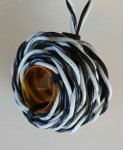Well I reached out to the manufacture of the lights. They told me they have no issue ,then today they send me an email. This is a section of the email of what is causing it
“GFI breakers in some applications is the cause because they are very sensitive to high or inconsistent levels of inrush current. Though the fixtures idle at low amperage there is a high inrush current to charge the many drivers in the fixtures.
Additionally, the amperage increases at a higher rate with each fixture but the amperage increases exponentially per fixture. For example, If 3 fixtures have an inrush current of 15 amps but adding a 4th fixture could bump the inrush current to 21amps, 22 amps, or higher which would trigger the breaker.
As mentioned earlier, GFI breakers are extremely sensitive to inconsistent current so even if the inrush current is under the max amp rating for the fixture the inbound flux can trip the GFI.
As a solution, we recommend using non-GFI/GFCI breakers”
so I understand the inrush, but would that inrush trigger the GFCI device?
I don’t see how so cause GFCI is sensing a current imbalance Not an overload.
if the inrush tripped a GFCI it would as do a standard breaker

